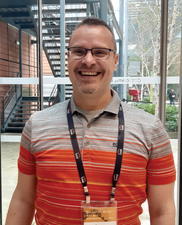The Big Picture
Interview – The Xen Project

Lars Kurth of the Xen Project talks about trends, markets, and the project's various threads of development.
There's nothing like someone's passing to get one to reflect on the fickle nature of life. The Xen Project's [1] very lively chairperson, Lars Kurth, sadly passed away not long after our interview at the Open Source Summit in November 2019. Lars had been with the project for almost a decade and was instrumental in several pivotal moments in Xen's history, including its move to the Linux Foundation. He conceptualized and executed several key decisions and supervised the significant architectural changes that helped the project go beyond the realm of server virtualization and cloud computing. In his last interview, Lars talked about the project's various threads of development and how Xen is all set to disrupt the auto industry.
Linux Magazine: What's happening with the Xen Project?
Lars Kurth: The big picture, ultimately, right now, is [that] there's a number of different trends happening. And I'm trying to kind of condense this into kind of [a] coherent strategy where different stakeholders in the community benefit from it. First, we have the server virtualization and the cloud market segment. Second, we have a whole segment of users, such as Qubes OS [2], and then there's similar products, which are used by the US military called SecureView. So that [SecureView] is based on open embedded, Xen, and extra bits and pieces of OpenXT [3], and they also [are] kind of rethinking the way how the platform is working and also rethinking the approach to Xen. So basically the idea there would be to take Xen as it is right now and just reduce it to the absolutely core minimum, basically as a separation hypervisor, but use the same code base, [and] Kconfig it down to something really small.
[...]
Buy this article as PDF
(incl. VAT)
Buy Linux Magazine
Subscribe to our Linux Newsletters
Find Linux and Open Source Jobs
Subscribe to our ADMIN Newsletters
Support Our Work
Linux Magazine content is made possible with support from readers like you. Please consider contributing when you’ve found an article to be beneficial.

News
-
Parrot OS Switches to KDE Plasma Desktop
Yet another distro is making the move to the KDE Plasma desktop.
-
TUXEDO Announces Gemini 17
TUXEDO Computers has released the fourth generation of its Gemini laptop with plenty of updates.
-
Two New Distros Adopt Enlightenment
MX Moksha and AV Linux 25 join ranks with Bodhi Linux and embrace the Enlightenment desktop.
-
Solus Linux 4.8 Removes Python 2
Solus Linux 4.8 has been released with the latest Linux kernel, updated desktops, and a key removal.
-
Zorin OS 18 Hits over a Million Downloads
If you doubt Linux isn't gaining popularity, you only have to look at Zorin OS's download numbers.
-
TUXEDO Computers Scraps Snapdragon X1E-Based Laptop
Due to issues with a Snapdragon CPU, TUXEDO Computers has cancelled its plans to release a laptop based on this elite hardware.
-
Debian Unleashes Debian Libre Live
Debian Libre Live keeps your machine free of proprietary software.
-
Valve Announces Pending Release of Steam Machine
Shout it to the heavens: Steam Machine, powered by Linux, is set to arrive in 2026.
-
Happy Birthday, ADMIN Magazine!
ADMIN is celebrating its 15th anniversary with issue #90.
-
Another Linux Malware Discovered
Russian hackers use Hyper-V to hide malware within Linux virtual machines.

